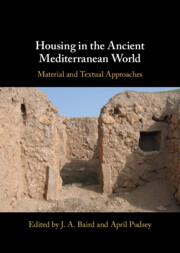Book contents
- Housing in the Ancient Mediterranean World
- Housing in the Ancient Mediterranean World
- Copyright page
- Contents
- Figures
- Tables
- Contributors
- Acknowledgements
- Introduction
- 1 Kinship ‘In the Halls’
- 2 Domesticating the Ancient House
- 3 Mind the Gap
- 4 A Family Affair
- 5 Textiles in Alkestis’ thalamos
- 6 Architectural Rhetoric and the Rhetoric of Architecture
- 7 The Reconstruction of an Agricultural Landscape
- 8 Mudbricks and Papyri from the Desert Sand
- 9 Housing and Community
- 10 The Elusive vestibulum
- 11 Living in the Liminal
- 12 Experiencing Sense, Place and Space in the Roman Villa
- 13 Houses and Time
- 14 Spaces of Desire
- 15 A Response: ‘Using the Material and Written Sources’ Revisited
- Index
- References
13 - Houses and Time
Material Memory at Dura-Europos
Published online by Cambridge University Press: 08 July 2022
- Housing in the Ancient Mediterranean World
- Housing in the Ancient Mediterranean World
- Copyright page
- Contents
- Figures
- Tables
- Contributors
- Acknowledgements
- Introduction
- 1 Kinship ‘In the Halls’
- 2 Domesticating the Ancient House
- 3 Mind the Gap
- 4 A Family Affair
- 5 Textiles in Alkestis’ thalamos
- 6 Architectural Rhetoric and the Rhetoric of Architecture
- 7 The Reconstruction of an Agricultural Landscape
- 8 Mudbricks and Papyri from the Desert Sand
- 9 Housing and Community
- 10 The Elusive vestibulum
- 11 Living in the Liminal
- 12 Experiencing Sense, Place and Space in the Roman Villa
- 13 Houses and Time
- 14 Spaces of Desire
- 15 A Response: ‘Using the Material and Written Sources’ Revisited
- Index
- References
Summary
One of the places where the disjuncture between the different qualities of written and material sources is perhaps most clear is in their temporal aspects. For example, ancient documents such as papyri were produced in a particular moment, within formal constraints of documentary practices. By contrast, the life cycles of houses tend to pivot around human – and less formal – scales of generational time: the biological life cycles of individual people and the life cycles of families. Archaeological houses hold the material memory of such cycles. This chapter examines the way the material form of the house can hold these different forms of time, and explores the way archaeological time can disrupt other ways of conceptualizing the past, for instance, in historical periodization. With specific reference to the houses of Dura-Europos in Arsacid and Roman Syria, the chapter questions the differing temporalities of the different forms of evidence and asks how these might be used together, avoiding the urge to force them to align, in order to paint a richer picture of ancient houses.
- Type
- Chapter
- Information
- Housing in the Ancient Mediterranean WorldMaterial and Textual Approaches, pp. 412 - 441Publisher: Cambridge University PressPrint publication year: 2022



